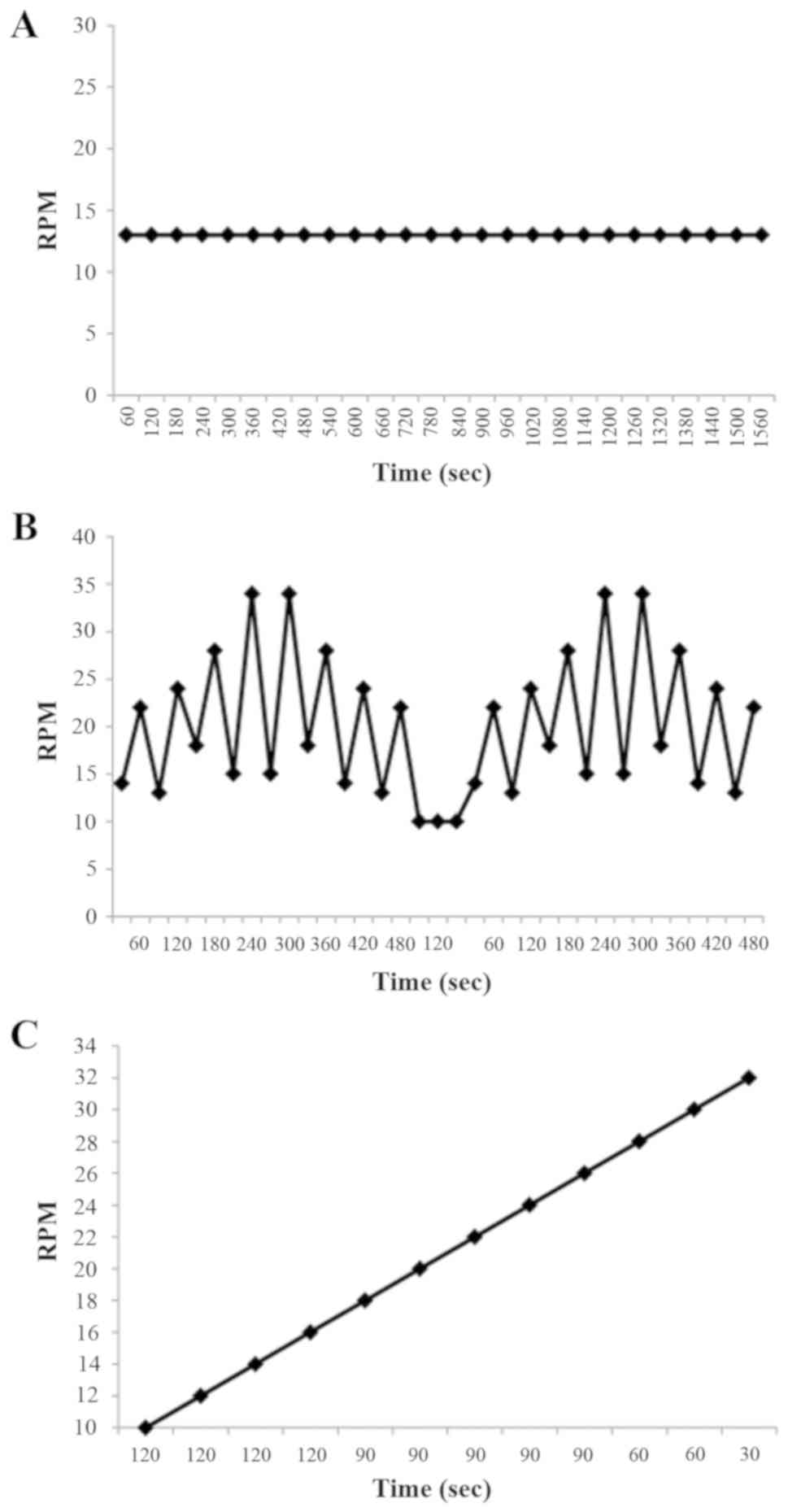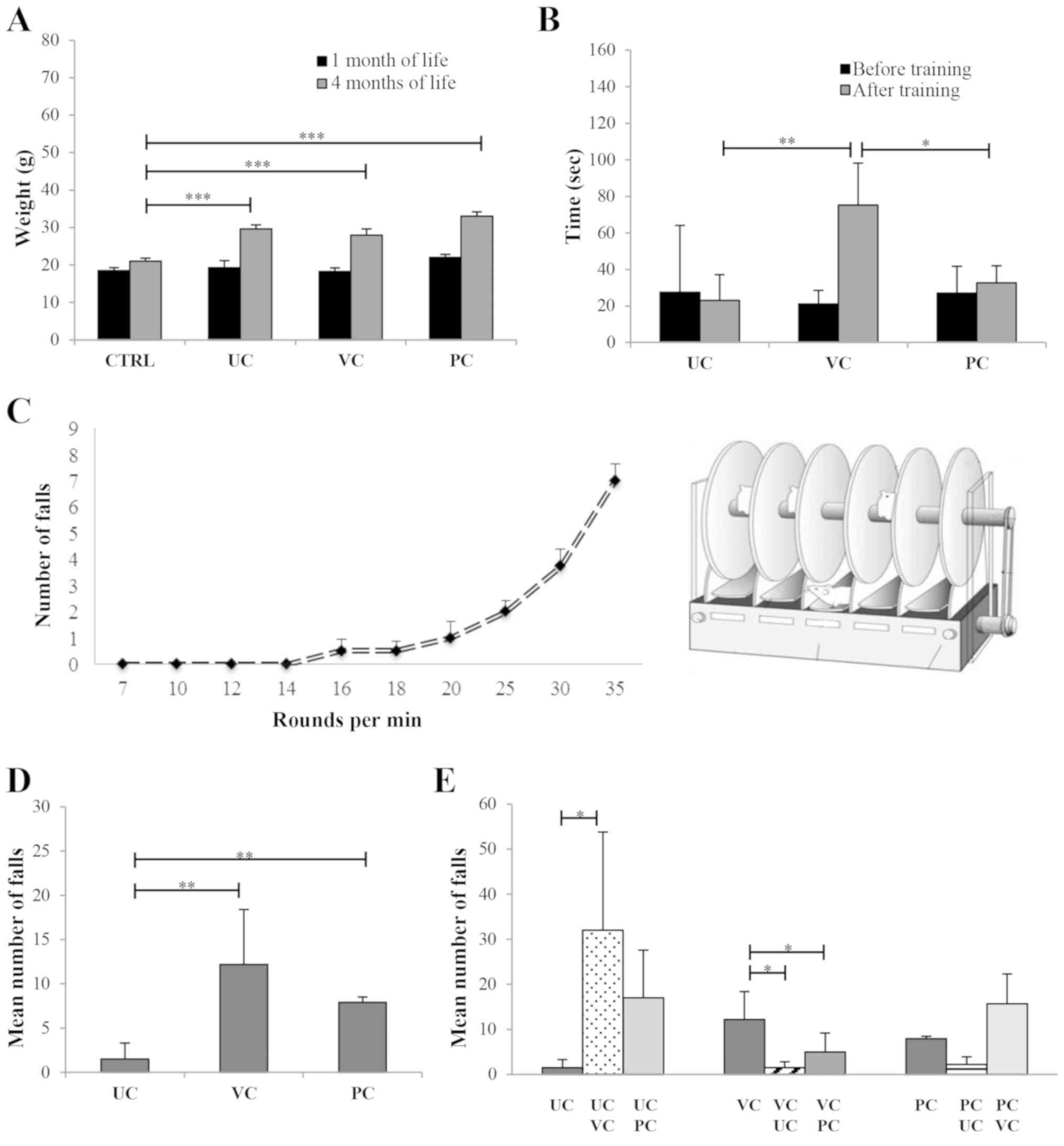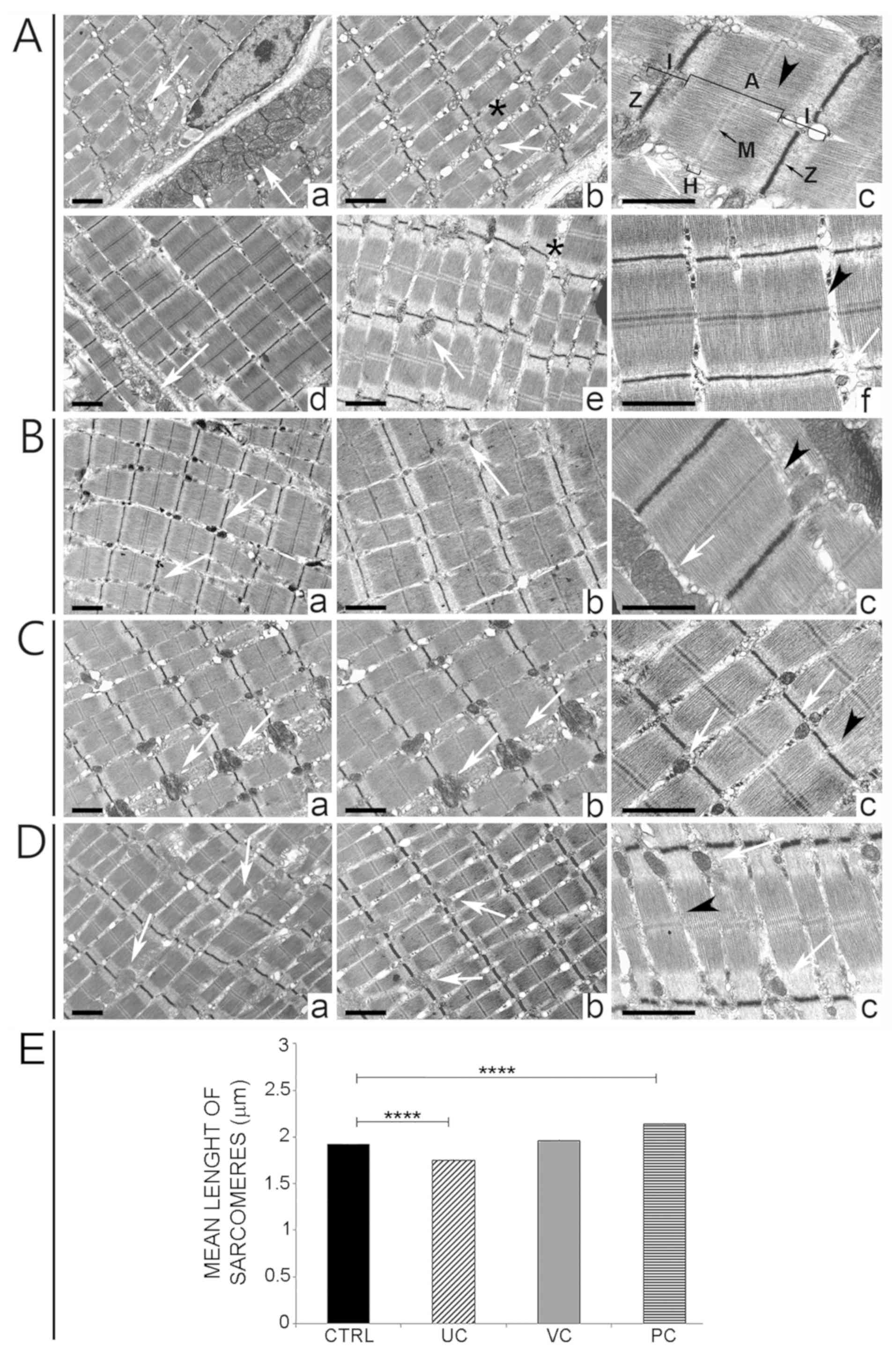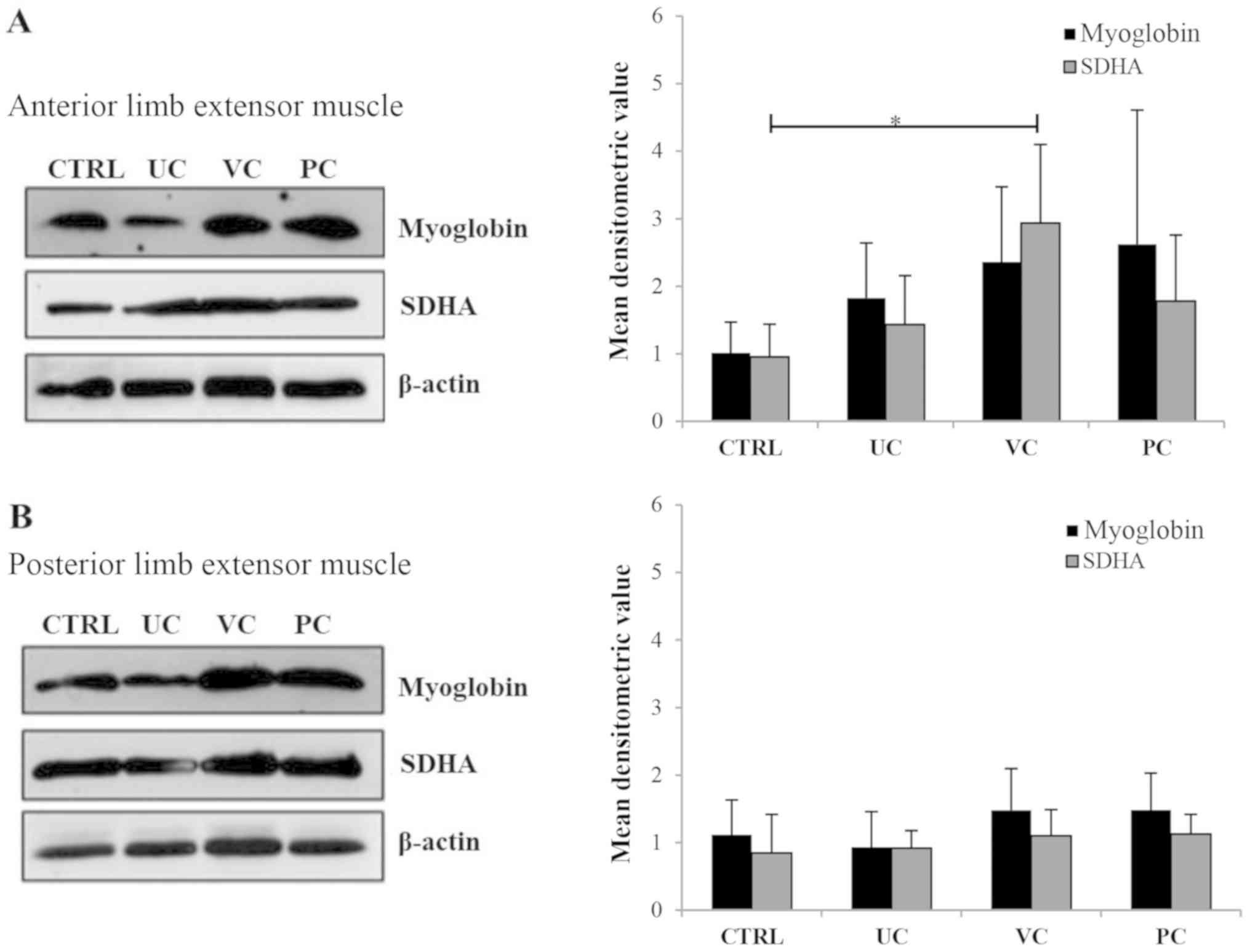|
1
|
Costill DL, Daniels J, Evans W, Fink W,
Krahenbuhl G and Saltin B: Skeletal muscle enzymes and fiber
composition in male and female track athletes. J Appl Physiol.
40:149–154. 1976.PubMed/NCBI View Article : Google Scholar
|
|
2
|
Harber M and Trappe S: Single muscle fiber
contractile properties of young competitive distance runners. J
Appl Physiol (1985). 105:629–636. 2008.PubMed/NCBI View Article : Google Scholar
|
|
3
|
Coyle EF: Integration of the physiological
factors determining endurance performance ability. Exerc Sport Sci
Rev. 23:25–63. 1995.PubMed/NCBI
|
|
4
|
Hawley JA: Adaptations of skeletal muscle
to prolonged, intense endurance training. Clin Exp Pharmacol
Physiol. 29:218–222. 2002.PubMed/NCBI View Article : Google Scholar
|
|
5
|
Fitts RH, McDonald KS and Schluter JM: The
determinants of skeletal muscle force and power: Their adaptability
with changes in activity pattern. J Biomech. 1:111–122.
1991.PubMed/NCBI View Article : Google Scholar
|
|
6
|
Fitts RH and Widrick JJ: Muscle mechanics:
Adaptations with exercise-training. Exerc Sport Sci Rev.
24:427–473. 1996.PubMed/NCBI
|
|
7
|
Goldspink G: Malleability of the motor
system: A comparative approach. J Exp Biol. 115:375–391.
1985.PubMed/NCBI
|
|
8
|
Hegarty PV and Hooper AC: Sarcomere length
and fibre diameter distributions in four different mouse skeletal
muscles. J Anat. 110:249–257. 1971.PubMed/NCBI
|
|
9
|
Widrick JJ, Stelzer JE, Shoepe TC and
Garner DP: Functional properties of human muscle fibers after
short-term resistance exercise training. Am J Physiol Regul Integr
Comp Physiol. 283:R408–R416. 2002.PubMed/NCBI View Article : Google Scholar
|
|
10
|
Fitts RH: New insights on sarcoplasmic
reticulum calcium regulation in muscle fatigue. J Appl Physiol
(1985). 111:345–346. 2011.PubMed/NCBI View Article : Google Scholar
|
|
11
|
Groennebaek T and Vissing K: Impact of
resistance training on skeletal muscle mitochondrial biogenesis,
content, and function. Front Physiol. 8(713)2017.PubMed/NCBI View Article : Google Scholar
|
|
12
|
Holloszy JO and Coyle EF: Adaptations of
skeletal muscle to endurance exercise and their metabolic
consequences. J Appl Physiol Respir Environ Exerc Physiol.
56:831–838. 1984.PubMed/NCBI View Article : Google Scholar
|
|
13
|
Hood DA: Contractile activity-induced
mitochondrial biogenesis in skeletal muscle. J Appl Physiol (1985).
90:1137–1157. 2001.PubMed/NCBI View Article : Google Scholar
|
|
14
|
Schantz PG: Plasticity of human skeletal
muscle with special reference to effects of physical training on
enzyme levels of the NADH shuttles and phenotypic expression of
slow and fast myofibrillar proteins. Acta Physiol Scand Suppl.
558:1–62. 1986.PubMed/NCBI
|
|
15
|
Lundberg TR, Fernandez-Gonzalo R,
Gustafsson T and Tesch PA: Aerobic exercise does not compromise
muscle hypertrophy response to short-term resistance training. J
Appl Physiol (1985). 114:81–89. 2013.PubMed/NCBI View Article : Google Scholar
|
|
16
|
Konopka AR and Harber MP: Skeletal muscle
hypertrophy after aerobic exercise training. Exerc Sport Sci Rev.
42:53–61. 2014.PubMed/NCBI View Article : Google Scholar
|
|
17
|
Tjønna AE, Lee SJ, Rognmo Ø, Stølen TO,
Bye A, Haram PM, Loennechen JP, Al-Share QY, Skogvoll E, Slørdahl
SA, et al: Aerobic interval training versus continuous moderate
exercise as a treatment for the metabolic syndrome: A pilot study.
Circulation. 118:346–354. 2008.PubMed/NCBI View Article : Google Scholar
|
|
18
|
Wisløff U, Støylen A, Loennechen JP,
Bruvold M, Rognmo Ø, Haram PM, Tjønna AE, Helgerud J, Slørdahl SA,
Lee SJ, et al: Superior cardiovascular effect of aerobic interval
training versus moderate continuous training in heart failure
patients: A randomized study. Circulation. 115:3086–3094.
2007.PubMed/NCBI View Article : Google Scholar
|
|
19
|
Alansare A, Alford K, Lee S, Church T and
Jung HC: The effects of high-intensity interval training vs.
Moderate-Intensity continuous training on heart rate variability in
physically inactive adults. Int J Environ Res Public Health.
15(E1508)2018.PubMed/NCBI View Article : Google Scholar
|
|
20
|
Gaitán JM, Eichner NZM, Gilbertson NM,
Heiston EM, Weltman A and Malin SK: Two weeks of interval training
enhances fat oxidation during exercise in obese adults with
prediabetes. J Sports Sci Med. 18:636–644. 2019.PubMed/NCBI
|
|
21
|
D'Arcangelo G, Triossi T, Buglione A,
Melchiorri G and Tancredi V: Modulation of synaptic plasticity by
short-term aerobic exercise in adult mice. Behav Brain Res.
332:59–63. 2017.PubMed/NCBI View Article : Google Scholar
|
|
22
|
Louhimies S: Directive 86/609/EEC on the
protection of animals used for experimental and other scientific
purposes. Altern Lab Anim. 2:217–219. 2002.PubMed/NCBI View Article : Google Scholar
|
|
23
|
D'Arcangelo G, Grossi D, Racaniello M,
Cardinale A, Zaratti A, Rufini S, Cutarelli A, Tancredi V, Merlo D
and Frank C: Miglustat reverts the impairment of synaptic
plasticity in a mouse model of NPC disease. Neural Plast.
2016(3830424)2016.PubMed/NCBI View Article : Google Scholar
|
|
24
|
Masuelli L, Focaccetti C, Cereda V, Lista
F, Vitolo D, Trono P, Gallo P, Amici A, Monaci P, Mattei M, et al:
Gene-Specific inhibition of breast carcinoma in BALB-neuT mice by
active immunization with rat neu or human ErbB receptors. Int J
Oncol. 30:381–392. 2007.PubMed/NCBI
|
|
25
|
Ballesta García I, Rubio Arias JÁ, Ramos
Campo DJ, Martínez González-Moro I and Carrasco Poyatos M:
High-Intensity interval training dosage for heart failure and
coronary artery disease cardiac rehabilitation. A systematic review
and meta-analysis. Rev Esp Cardiol (Engl Ed). 72:233–243.
2019.PubMed/NCBI View Article : Google Scholar
|
|
26
|
Ballesta-García I, Martínez González-Moro
I, Rubio-Arias JÁ and Carrasco-Poyatos M: High-Intensity interval
circuit training versus moderate-intensity continuous training on
functional ability and body mass index in middle-aged and older
women: A randomized controlled trial. Int J Environ Res Public
Health. 16(E4205)2019.PubMed/NCBI View Article : Google Scholar
|
|
27
|
Mannella CA: Structural diversity of
mitochondria: Functional implications. Ann NY Acad Sci.
1147:171–179. 2008.PubMed/NCBI View Article : Google Scholar
|
|
28
|
Gordon AM, Huxley AF and Julian FJ: The
variation in isometric tension with sarcomere length in vertebrate
muscle fibres. J Physiol. 184:170–192. 1966.PubMed/NCBI View Article : Google Scholar
|
|
29
|
Herzog W and Leonard TR: Force enhancement
following stretching of skeletal muscle: A new mechanism. J Exp
Biol. 205:1275–1283. 2002.PubMed/NCBI
|
|
30
|
Riis S, Christensen B, Nellemann B, Møller
AB, Husted AS, Pedersen SB, Schwartz TW, Jørgensen JOL and Jessen
N: Molecular adaptations in human subcutaneous adipose tissue after
ten weeks of endurance exercise training in healthy males. J Appl
Physiol (1985). 126:569–577. 2019.PubMed/NCBI View Article : Google Scholar
|
|
31
|
Cochran AJ, Percival ME, Tricarico S,
Little JP, Cermak N, Gillen JB, Tarnopolsky MA and Gibala MJ:
Intermittent and continuous high-intensity exercise training induce
similar acute but different chronic muscle adaptations. Exp
Physiol. 99:782–791. 2014.PubMed/NCBI View Article : Google Scholar
|
|
32
|
Aisbett B, Condo D, Zacharewicz E and
Lamon S: The impact of shiftwork on skeletal muscle health.
Nutrients. 9(E248)2017.PubMed/NCBI View Article : Google Scholar
|
|
33
|
Dobbins M, Husson H, DeCorby K and LaRocca
RL: School-Based physical activity programs for promoting physical
activity and fitness in children and adolescents aged 6 to 18.
Cochrane Database Syst Rev. 2(CD007651)2013.PubMed/NCBI View Article : Google Scholar
|


















